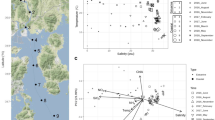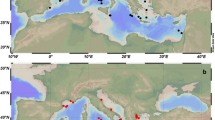Abstract
Microbial communities live on macroalgal surfaces. The identity and abundance of the bacteria making these epiphytic communities depend on the macroalgal host and the environmental conditions. Macroalgae rely on epiphytic bacteria for basic functions (spore settlement, morphogenesis, growth, and protection against pathogens). However, these marine bacterial-macroalgal associations are still poorly understood for macroalgae inhabiting the Colombian Caribbean. This study aimed at characterizing the epiphytic bacterial community from macroalgae of the species Ulva lactuca growing in La Punta de la Loma (Santa Marta, Colombia). We conducted a 16S rRNA gene sequencing-based study of these microbial communities sampled twice a year between 2014 and 2016. Within these communities, the Proteobacteria, Bacterioidetes, Cyanobacteria, Deinococcus-Thermus and Actinobacteria were the most abundant phyla. At low taxonomic levels, we found high variability among epiphytic bacteria from U. lactuca and bacterial communities associated with macroalgae from Germany and Australia. We observed differences in the bacterial community composition across years driven by abundance shifts of Rhodobacteraceae Hyphomonadaceae, and Flavobacteriaceae, probably caused by an increase of seawater temperature. Our results support the need for functional studies of the microbiota associated with U. lactuca, a common macroalga in the Colombian Caribbean Sea.





Similar content being viewed by others
Data Availability
The datasets generated during and/or analysed during the current study are available from the corresponding author on reasonable request.
References
Stabili L, Rizzo L, Pizzolante G, Alifano P, Fraschetti S (2017) Spatial distribution of the culturable bacterial community associated with the invasive alga Caulerpa cylindracea in the Mediterranean Sea. Mar Environ Res 125:90–98. https://doi.org/10.1016/j.marenvres.2017.02.001
Wu Y, Zhao C, Xiao Z, Lin H, Ruan L, Liu B (2016) Metagenomic and proteomic analyses of a mangrove microbial community following green macroalgae Enteromorpha prolifera degradation. J Microbiol Biotechnol 26:2127–2137. https://doi.org/10.4014/jmb.1607.07025
Van der Loos L, Eriksson B, Salles J (2019) The macroalgal holobiont in a changing sea. Trends Microbiol 27:635–650. https://doi.org/10.1016/j.tim.2019.03.002
Florez J, Camus C, Hengst M, Marchant F, Buschmann A (2019) Structure of the epiphytic bacterial communities of Macrocystis pyrifera in localities with contrasting nitrogen concentrations and temperature. Algal Res. https://doi.org/10.1016/j.algal.2019.101706
Burke C, Steinberg P, Rusch D, Kjelleberg S, Thomas T (2011) Bacterial community assembly based on functional genes rather than species. Proc Natl Acad Sci USA 108:14288–14293. https://doi.org/10.1073/pnas.1101591108
Aires T, Serrão EA, Engelen AH (2016) Host and environmental specificity in bacterial communities associated to two highly invasive marine species (genus Asparagopsis). Front Microbiol 7:1–14. https://doi.org/10.3389/fmicb.2016.00559
Mineta K, Gojobori T (2016) Databases of the marine metagenomics. Gene 576:724–728. https://doi.org/10.1016/j.gene.2015.10.035
Aires T, Moalic Y, Serrao EA, Arnaud-Haond S (2015) Hologenome theory supported by cooccurrence networks of species-specific bacterial communities in siphonous algae (Caulerpa). FEMS Microbiol Ecol 91:1–14. https://doi.org/10.1093/femsec/fiv067
Longford SR, Tujula NA, Crocetti GR, Holmes AJ, Holmstrӧm C, Kjelleberg S, Steinberg PD, Taylor MW (2007) Comparisons of diversity of bacterial communities associated with three sessile marine eukaryotes. Aquat Microb Ecol 48:217–229
Lachnit T, Blϋmel M, Imhoff J, Wahl M (2009) Specific epibacterial communities on macroalgae: phylogeny matters more than habitat. Aquat Biol 5:181–186. https://doi.org/10.3354/ab00149
Tujula NA, Crocetti GR, Burke C, Thomas T, Holmstrӧm C, Kjelleberg S (2010) Variability and abundance of the epiphytic bacterial community associated with a green marine Ulvacean alga. ISME J 4:301–311. https://doi.org/10.1038/ismej.2009.107
Lachnit T, Meske D, Wahl M, Harder T, Schmitz R (2011) Epibacterial community patterns on marine macroalgae are host-specific but temporally variable. Environ Microbiol 13:655–665. https://doi.org/10.1111/j.1462-2920.2010.02371.x
Singh RP, Reddy CRK (2016) Unraveling the functions of the macroalgal microbiome. Front Microbiol 6:1–8. https://doi.org/10.3389/fmicb.2015.01488
Burke C, Thomas T, Lewis M, Steinberg P, Kjelleberg S (2011) Composition, uniqueness and variability of the epiphytic bacterial community of the green alga Ulva australis. ISME J 5:590–600
Díaz G, Díaz M (2003) Diversity of benthic marine algae of the Colombian Atlantic. Biota Colomb 4:203–246
García CB, Díaz-Pulido G (2006) Dynamics of a macroalgal rocky intertidal community in the Colombian Caribbean. Bol Invest Mar Cost 35:7–18
Zotta T, Guidone A, Tremonte P, Parente E, Ricciardi A (2012) A comparison of fluorescent stains for the assessment of viability and metabolic activity of lactic acid bacteria. World J Microbiol Biotechnol 28:919–927. https://doi.org/10.1007/s11274-011-0889-x
Klindworth A, Pruesse E, Schweer T, Peplies J, Quast C, Horn M, Glöckner F (2013) Evaluation of general 16S ribosomal RNA gene PCR primers for classical and next-generation sequencing-based diversity studies. Nucleic Acids Res 41:1–11. https://doi.org/10.1093/nar/gks808
Caporaso JG, Kuczynski J, Stombaug J, Bittinger K, Bushman FD, Costello EK, Fierer N, Peña AG, Goodrich JK, Gordon JI, Huttley GA, Kelley ST, Knights D, Koenig JE, Ley RE, Lozupone CA, McDonald D, Muegge BD, Pirrung M, Reeder J, Sevinsky JR, Turnbaug PJ, Walters WA, Widmann J, Yatsunenko T, Zaneveld J, Knight R (2010) QIIME allows analysis of high-throughput community sequencing data. Nat Methods 7:335–336. https://doi.org/10.1038/nmeth.f.303
Lozupone C, Knight R (2005) UniFrac: A new phylogenetic method for comparing microbial communities. Appl Environ Microbiol 71:8228–8235. https://doi.org/10.1128/AEM.71.12.8228-8235.2005
R Development Core Team (2011) R: A Language and Environment for Statistical Computing. Vienna, Austria: the R Foundation for Statistical Computing. ISBN: 3–900051–07–0. http://www.R-project.org/.
Gomes N, Cleary D, Pires A, Almeida A, Cunha A, Mendonça-Hagler L, Smalla K (2014) Assessing variation in bacterial composition between the rhizospheres of two mangrove tree species. Estuar Coast Shelf Sci 139:40–45. https://doi.org/10.1016/j.ecss.2013.12.022
Ho J, Adeolu M, Khadka B, Gupta RS (2016) Identification of distinctive molecular traits that are characteristics of the phylum “Deinococcus-Thermus” and distinguish its main constituent groups. Syst Appl Microbiol 39:453–463. https://doi.org/10.1016/j.syapm.2016.07.003
Dogs M, Wemheuer B, Wolter L, Bergen N, Daniel R, Simon M, Brinkhoff T (2017) Rhodobacteraceae on the marine brown alga Fucus spiralis are abundant and show physiological adaptation to an epiphytic lifestyle. Syst Appl Microbiol 40:370–382. https://doi.org/10.1016/j.syapm.2017.05.006
Jain A, Krishnan K, Begum N, Singh A, Thomas F, Gopinath A (2020) Response of bacterial communities from Kongsfjorden (Svalbard, Arctic Ocean) to macroalgal polysaccharide amendments. Mar Environ Res 155:1–10. https://doi.org/10.1016/j.marenvres.2020.104874
Hosoya S, Arunpairojana V, Suwannachart C, Opas A, Yokota A (2006) Aureispira marina gen. nov., sp. nov., a gliding, arachidonic acid-containing bacterium isolated from the southern coastline of Thailand. Int J Syst Evol Microbiol 56:2931–2935. https://doi.org/10.1099/ijs.0.64504-0
Bondoso J, Vitorino F, Balagué V, Gasol J, Harder J, Lage O (2017) Epiphytic Planctomycetes communities associated with three main groups of macroalgae. FEMS Microbiol Ecol 93:1–9. https://doi.org/10.1093/femsec/fiw255
Alain K, Tindall B, Intertaglia L, Catala P, Lebaron P (2008) Hellea balneolensis gen. nov., sp. nov., a prosthecate alphaproteobacterium from the Mediterranean Sea. Int J Syst Evol Microbiol 58:2511–2519. https://doi.org/10.1099/ijs.0.65424-0
Nelson CE, Goldberg SJ, Wegley Kelly L, Haas AF, Smith JE, Rohwer F, Carlson CA (2013) Coral and macroalgal exudates vary in neutral sugar composition and differentially enrich reef bacterioplankton lineages. ISME J 7:962–979. https://doi.org/10.1038/ismej.2012.161
Florez J, Camus C, Hengst M, Buschmann A (2017) A functional perspective analysis of macroalgae and epiphytic bacterial community interaction. Front Microbiol 8:1–6. https://doi.org/10.3389/fmicb.2017.02561
Park S, Jung YT, Won SM, Park JM, Yoon JH (2014) Granulosicoccus undariae sp.nov., a member of the family Granulosicoccaceae isolated from a brown algae reservoir and emended description of the genus Granulosicoccus. Antonie Leeuwenhoek 106:845–852. https://doi.org/10.1007/s10482-014-0254-9
Behera P, Mahapatra S, Mohapatra M, Kim JY, Adhya TK, Raina V, Suar M, Pattnaik AK, Rastogi G (2017) Salinity and macrophyte drive the biogeography of the sedimentary bacterial communities in a brackish water tropical coastal lagoon. Sci Total Environ 595:472–485. https://doi.org/10.1016/j.scitotenv.2017.03.271
Ramirez-Puebla T, Weigel BL, Jack L, Schlundt C, Pfister CA, Welch JLM (2020) Spatial organization of the kelp microbiome at micron scales. J Mar Biol Assoc UK. https://doi.org/10.1101/2020.03.01.972083
Yoon J, Adachi K, Kasai H (2015) Isolation and characterization of a novel Bacteroidetes as Algitalea ulvae gen.nov.sp.nov., isolated from the green alga Ulva pertusa. Antonie Leeuwenhoek 108:505–513. https://doi.org/10.1007/s10482-015-0504-5
Xie X, He Z, Hu X, Yin H, Liu X, Yang Y (2017) Large-scale seaweed cultivation diverges water and sediment microbial communities in the coast of Nan’ao Island, South China Sea. Sci Total Environ 598:97–108. https://doi.org/10.1016/j.scitotenv.2017.03.233
Kientz B, Agogué H, Lavergne C, Marié P, Rosenfeld E (2013) Isolation and distribution of iridescent Cellulophaga and other iridescent marine bacteria from the Charente-Maritime coast, French Atlantic. Syst Appl Microbiol 36:244–251. https://doi.org/10.1016/j.syapm.2013.02.004
Yoon J, Katsuta A, Kasai H (2012) Rubidimonas crustatorum gen. nov., sp. nov., a novel member of the family Saprospiraceae isolated from a marine crustacean. Antonie Leeuwenhoek 101:461–467. https://doi.org/10.1007/s10482-011-9653-3
Guzmán S, Carreón L, Belmar J, Carrillo J, Herrera R (2003) Effects of the “El Niño” event on the recruitment of benthic invertebrates in Bahía Tortugas, Baja California Sur. Geofis Int 42:429–438
Hernández G, Riosmena R, Serviere E, Ponce G (2011) Effect of nutrient availability on understory algae during El Niño Southern Oscillation (ENSO) conditions in Central Pacific Baja California. J Appl Phycol 23:635–642. https://doi.org/10.1007/s10811-011-9656-5
Carballo J, Olabarria C, Garza T (2002) Analysis of four macroalgal assemblages along the Pacific Mexican coast during and after the 1997–98 El Niño. Ecosystems 5:749–760. https://doi.org/10.1007/s10021-002-0144-2
Xia P, Yan D, Sun R, Song X, Lin T, Yi Y (2020) Community composition and correlations between bacteria and algae within epiphytic biofilms on submerged macrophytes in a plateau lake, southwest China. Sci Total Environ. https://doi.org/10.1016/j.scitotenv.2020.138398
Acknowledgements
The research was funded by the Corporation Center of Excellence in Marine Sciences (CEMarin) (Call No. 8, 2016). ANLA (Agencia Nacional de Licencias Ambientales) and Ministerio de Ambiente y Desarrollo Sostenible granted permission to collect samples and perform this research (Resolution No. 0255 of 14/03/2014). The authors thank the Instituto de Biotecnología de la Universidad Nacional de Colombia, the Direction of Investigation and Extension of the Universidad Nacional de Colombia and the PhD Scholarship Program of Minciencias.
Funding
The research was funded by the Corporation Center of Excellence in Marine Sciences (CEMarin) (Call No. 8, 2016).
Author information
Authors and Affiliations
Contributions
Natalia Comba, Liliana López and Dolly Montoya conceived and designed research. Natalia Comba and Nicolás Niño conducted experiments. Natalia Comba, Liliana López and Dolly Montoya analyzed data. Natalia Comba wrote the manuscript. All authors read and approved the manuscript.
Corresponding author
Ethics declarations
Conflicts of interest
The authors declare that they have no conflict of interest.
Ethics Approval
No animal testing was performed during this study.
Sampling and Field Studies
All necessary permits for sampling and observational field studies have been obtained by the authors from the competent authorities and are mentioned in the acknowledgements.
Additional information
Publisher's Note
Springer Nature remains neutral with regard to jurisdictional claims in published maps and institutional affiliations.
Supplementary Information
Below is the link to the electronic supplementary material.
Rights and permissions
About this article
Cite this article
Comba González, N.B., Niño Corredor, A.N., López Kleine, L. et al. Temporal Changes of the Epiphytic Bacteria Community From the Marine Macroalga Ulva lactuca (Santa Marta, Colombian-Caribbean). Curr Microbiol 78, 534–543 (2021). https://doi.org/10.1007/s00284-020-02302-x
Received:
Accepted:
Published:
Issue Date:
DOI: https://doi.org/10.1007/s00284-020-02302-x




